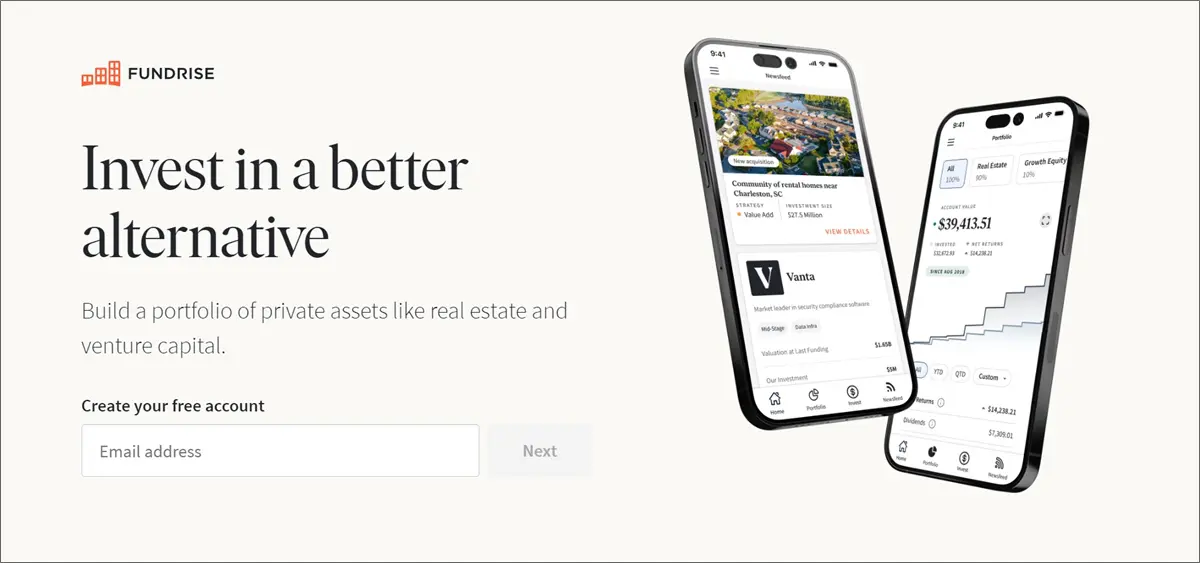Table of Contents
In 2015, I started building what I call “my cash flow portfolio.” This is a specific set of investments designed first and foremost to generate interest and dividends.
My thinking was: how can I get paid over and over again from work I do once?
And by investing for cash flow, I could turn every “extra” $1,000 I earned into $20-80 a year in truly passive income … forever.
I diligently added to to my cash flow portfolio month after month, year after year. Today, it generates thousands of dollars a month.
One component of that portfolio is commercial real estate through Fundrise.
Disclosure: I’m a long-time Fundrise investor and affiliate partner. When you join through my referral link, I earn a commission. Opinions are my own.

In this post, I’ll break down:
- How Fundrise works
- What attracted me to the platform
- The pros and cons
- A glimpse into my Fundrise account
- Alternatives to consider
Ready? Let’s do it!
Fundrise Review
-
Performance -
Ease of Use -
Liquidity -
Diversification
Fundrise Summary
Fundrise is one of the best and largest crowdfunded real estate investment platforms, with $7B under management. The company makes institutional quality investments available to everyone, starting at just $10.
What is Fundrise?
Why I Chose to Invest
I was attracted to Fundrise for several reasons, including:
- the draw of consistent cash flow
- wanting to add real estate exposure to my portfolio
- the company philosophy
Consistent Cash Flow
I’ve been a Fundrise investor since late 2015, and they’ve paid dividends every quarter since then. Since one of my goals was to build up my passive income, the prospect of 8%+ dividend yields early on was pretty attractive.
(Those have since decreased as the platform has matured and diversified.)
Adding Real Estate Exposure
Historically, real estate investors have benefitted from:
- Property appreciation
- Rental income
- Favorable tax treatment
And since some experts recommend up to 20% of your portfolio in real estate, I was looking for ways to add some — without being a landlord.
Company Philosophy
I resonated with Fundrise’s investment philosophy, which I can best describe as cautiously optimistic. The company wasn’t seeking to acquire every category of property in the name of diversification, but focused on a few they felt strongly about.
Those include:
- “Last mile” logistics facilities
- Sunbelt residential properties
Those made sense to me, especially compared to shopping malls and office buildings in the age of e-commerce and remote work.
Fundrise’s messaging was (and still is), “tech-enabled, vetted real estate, built for strong long-term returns.” I think I was attracted to the level-headedness of it all.
I started with a $5000 deposit to test the waters, and have been adding to my account ever since.
Pros and Cons of Fundrise
Pros:
- Low Minimum Investment — You can start with as little as $10.
- Open to Everyone — Some platforms are only open to accredited investors.
- Low Fees — Fundrise charges 1% of your account value in fees every year.
- Instant Diversification — No having to pick and choose deals. Your risk is spread around into a curated set of commercial properties.
- Healthy Historical Performance — My account has earned 10% annualized. Looking at dividend income only, the average annualized return is 5.29%.
- Lower Volatility — Because of the conservative strategy, Fundrise isn’t hit as hard as public REITs during market downturns.

Cons:
- Liquidity — If you need to pull cash out of your account, you can do so without penalty once a quarter. But, Fundrise also reserves the right to suspend these withdrawals depending on market conditions. This should definitely be seen as a long-term hold.
- Not as Diversified — Public REITs like Vanguard’s VNQ give you exposure to thousands of properties, where with Fundrise, you may only have a few dozen.
- Limited Operational Track Record — The company has only been in business since 2012.
- Weaker Upside — With lower downside volatility comes weaker upside performance when the market is booming.
Inside My Fundrise Account
Here’s what it looks like inside my Fundrise account. The little stair-steps on the chart are where I’ve deposited more money over time.

If I toggle to Net Returns, I can see that the account has earned over $42,000 since I started — split between dividends and appreciation.

The interesting thing here is the big run-up in appreciation during the 2021 real estate boom, and subsequent correction the following year.
Since I was trying to build my passive cash flow, the quarterly dividend metric is more important to me. Lately, that’s been around $1200 a quarter, or $400 a month.
Inside the portfolio, my account holds 169 active projects:

Those are split into two broad categories:
- Growth Real Estate
- Income Real Estate
Historically, the “Growth” portion has delivered stronger returns.

Initially, I had my goal set as “income,” but Fundrise would automatically allocate new investments across both growth and income eREITs. Now you can choose the specific eREITs that most closely align with your goals.
As an example, here are some of the properties included in my Fundrise portfolio:

Who Should Avoid Fundrise Like the Plague?
Fundrise isn’t a good fit if you:
- Need near-term liquidity
- Think the real estate market is going to crash
- Love the roller coaster of public REITs
- Prefer direct real estate investment, like buying houses yourself
Fundrise Alternatives
When it comes to making money from real estate, Fundrise is just one of many options. Here are some alternatives to consider.
Other Real Estate Crowdfunding Sites
Several other platforms operate similarly to Fundrise, though they usually have higher minimum investments and may be open to accredited investors only:
- Yieldstreet — Diversify into real estate, art, private credit, and more. $10,000 minimums; accredited investors only.
- Crowdstreet — $25,000 minimums; accredited investors only.
- EquityMultiple — $5,000 minimums; accredited investors only.
- Diversyfund — Specializes in multifamily residential properties. $500 minimum investment.
Public REITs
You can also buy shared in low-cost real estate investment trusts through any brokerage. These are part of my cash flow portfolio as well.
For example, here’s how Vanguard’s VNQ has fared over the last few years.

The shares are worth roughly the same as they were 8 years ago, but the fund has paid dividends every quarter.
Build Your Own Real Estate Portfolio
Many Side Hustle Nation readers prefer a more active real estate side hustle.
For people like Dustin Heiner, his empire of rental properties spins off enough cash flow that he retired early. This style of direct investment takes more work, but allows you more leverage and tax benefits than Fundrise does.
For example, with $100,000 as down payment money, I could buy $500,000 worth of rental property. Then my tenants would slowly pay off the mortgage(s) for me and I’d theoretically earn relatively passive cash flow every month.
(All while writing off my business expenses, depreciation, and mortgage interest from my taxes.)
In exchange, you’ll be in charge of:
- maintenance
- problem tenants
- vacancies
For some, those responsibilities are a small price to pay as a way to build long-term wealth and escape the rat race.
If you don’t want to deal with that stuff but still like the idea of single family rental income, check out a platform like Arrived. You can buy fractional ownership of cash-flowing rentals for as little as $100, and be completely hands-off.

Fundrise by the Numbers
Here are some Fundrise stats to consider:
- Fundrise is one of the 50 largest real estate private equity investors.
- The company currently manages over $7B in real estate.
- Nearly 2M investors have joined the platform.
- Named “Best real estate crowdfunding site for beginners” by Investopedia.
- Named “Best real estate investing app” by Business Insider.
Hopefully this article shed some light on whether Fundrise makes sense to add to your investment portfolio.
Looking for More Side Hustle Help?




.png#keepProtocol)



.png#keepProtocol)
More Stories
Employee Appreciation Day: How to build a culture of year-round recognition
Data Never Sleeps Turns 11!
George Jenkins’ Alyssa Currie signs first bowling scholarship in school history